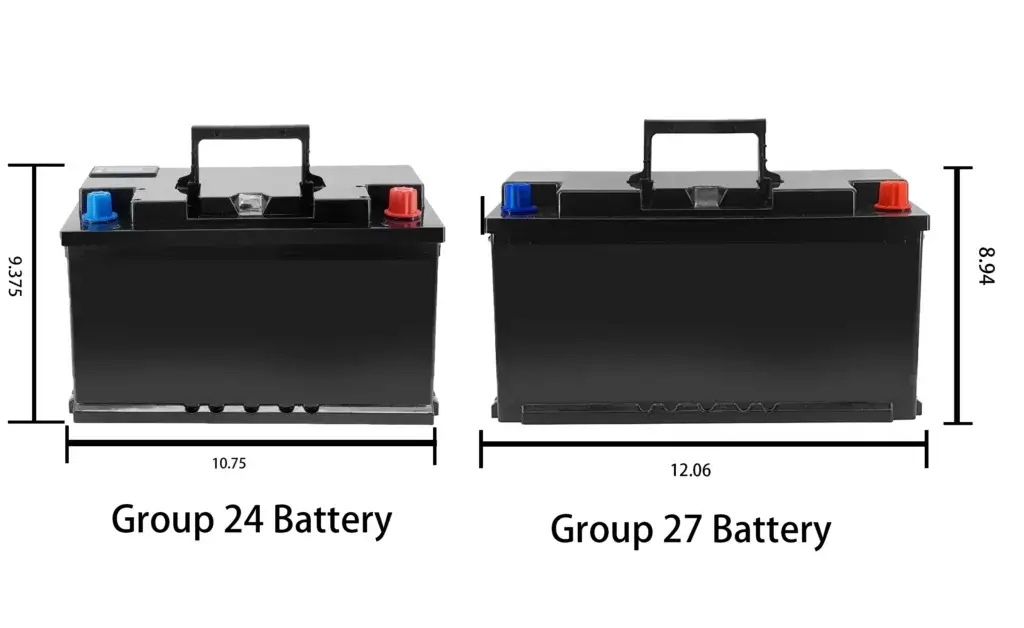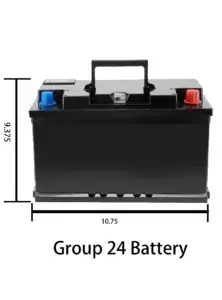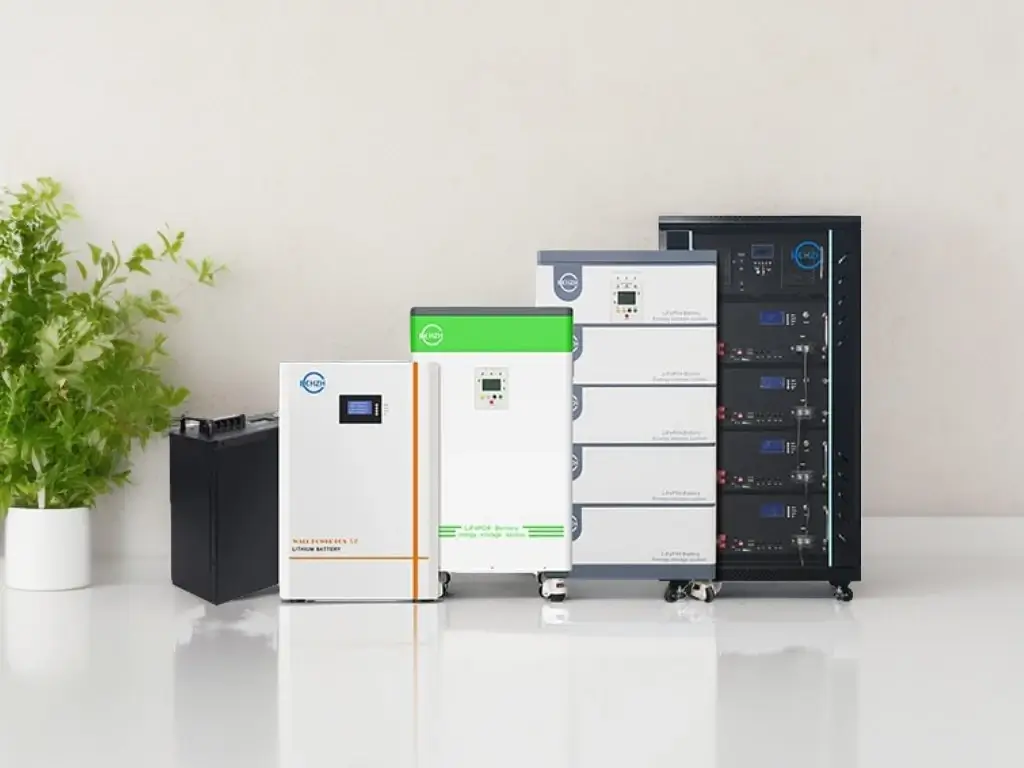Powering Your Equipment Batteries play a vital role in ensuring the smooth operation and functionality of your vehicle. Whether you need a lithium battery pack for golf carts, string outboards, marine, forklifts, or sweepers, then there is no getting away from choosing a reliable lithium battery pack. This article will take a look at Group 24 VS Group 27 batteries.

Group 24 VS Group 27 batteries are the most popular contenders. Both groups of batteries are widely recognized for their performance and compatibility with a wide range of vehicles. Whether it’s a compact car a rugged truck trail or something else in between, understanding the difference between Group 24 VS Group 27 batteries is essential to equipping your vehicle with the power it deserves. Join us as we dive deeper into this showdown and uncover the intricate details behind these powerful batteries.
Group 24 and Group 27 Batteries – Each battery has its unique benefits and features. This article focuses on vehicle sector use while illuminating these choices by examining various aspects of size, capacity, performance metrics, and suitability for different types of vehicles. Prepare to embark on a journey that will unveil the hidden dynamics behind your automobile through an in-depth comparison of these two rugged groups of batteries.
Introduction
The heartbeat of any vehicle lies in its ability to harness power for propulsion and operation, and at the core of this power lies the humble battery. Batteries serve as the lifeblood that electrifies our vehicles, providing the necessary energy to start engines, illuminate headlights, and power vital systems. Without a reliable battery, even the most sophisticated vehicle would be rendered inert.
Brief Overview: The Power Within
Beyond their fundamental role in starting an engine, batteries play a crucial role in maintaining a stable electric supply for various components within a vehicle. From powering electronic systems like GPS and entertainment units to ensuring safety features such as airbags are operational, batteries are an indispensable component of modern automobiles.
Deciphering Group 24 vs Group 27 Batteries
In this comprehensive analysis, we delve into the nuanced differences and surprising similarities between Group 24 and Group 27 batteries. By unraveling their unique specifications, applications, advantages, and disadvantages, we aim to equip readers with the knowledge needed to make informed decisions when it comes to selecting the optimal battery for their vehicles. Join us on this illuminating journey as we navigate through the intricacies of these powerhouse components!
Understanding Battery Groups
The Significance of Battery Groups
Battery groups, such as Group 24 and Group 27, play a crucial role in determining the size, capacity, and compatibility of batteries with different vehicles. These groups are standardized classifications that help both consumers and manufacturers identify the right battery for specific applications.
The size of a battery group directly correlates with its physical dimensions, which in turn affects its capacity and performance capabilities. Understanding these group classifications is essential for ensuring that your vehicle receives the power it requires to function optimally.
The Importance of Selecting the Right Battery Group
Selecting the appropriate battery group is paramount because it directly impacts your vehicle’s performance and longevity. Choosing a battery that aligns with your vehicle’s specific requirements ensures optimal power delivery, reliable starting capabilities, and efficient electrical system operation.
Installing a battery that is incompatible or insufficient for your vehicle may lead to issues such as slow engine cranking, electrical malfunctions, or even complete system failure. Therefore, taking into consideration factors like size, capacity, and compatibility when selecting a battery group can ultimately enhance your vehicle’s overall performance while prolonging its lifespan.
Group 24 Battery Deep Dive
Overview of Specifications

When delving into the specifics of a Group 24 battery, one must first consider its dimensions, which typically measure around 10.75 inches in length, 6.8125 inches in width, and 9.375 inches in height. These dimensions make it a suitable fit for a wide range of vehicles, from sedans to smaller trucks.
In terms of voltage, Group 24 batteries are commonly rated at 12 volts, providing ample power to start your vehicle and run its various electrical components efficiently. Additionally, the reserve capacity of a Group 24 battery usually hovers around 100-120 minutes, indicating how long the battery can consistently deliver power before needing recharging.
Common Applications
Group 24 batteries find widespread use in sedans, compact cars, SUVs, and light trucks due to their versatile size and power output. Sedans and smaller vehicles benefit greatly from the reliable performance of Group 24 batteries during daily commutes or short trips where consistent starting power is crucial. Their compatibility with a range of vehicle types makes them a popular choice among drivers looking for a dependable battery option that fits within their vehicle’s designated battery compartment.
Pros and Cons
One notable advantage of using a Group 24 battery is its compact size relative to its power output. This makes it ideal for vehicles with limited space under the hood or trunk area where the battery needs to be installed.
Additionally, Group 24 batteries are often more affordable compared to larger battery groups while still offering sufficient cranking power for most standard vehicles. However, one potential disadvantage lies in their reserve capacity compared to larger battery groups like Group 27; while suitable for regular driving conditions, they may struggle with extended periods of heavy electrical usage or extreme weather conditions that demand higher energy reserves.
Group 27 Battery Deep Dive

Overview of Specifications
When delving into the realm of Group 27 batteries, one must first grasp the key specifications that set them apart. In terms of dimensions, Group 27 batteries typically measure around 12.06 inches in length, 6.81 inches in width, and 8.94 inches in height, making them larger than their Group 24 counterparts.
Voltage-wise, these robust batteries usually boast a standard voltage of 12 volts, providing ample power for larger vehicles with higher energy demands. Moreover, Group 27 batteries often offer an impressive reserve capacity ranging from approximately 100 to 130 minutes, ensuring prolonged performance and reliability.
Common Applications
Group 27 batteries are revered for their versatility and resilience, making them a popular choice for a wide array of vehicles requiring substantial power outputs. These batteries are commonly found powering trucks, SUVs, RVs, and other larger vehicles that demand reliable starting power and extended battery life. Their ability to withstand heavy-duty usage in challenging environments makes them indispensable for off-road adventures as well as commercial fleet operations where durability is paramount.
Pros and Cons
Utilizing a Group 27 battery presents motorists with several advantages that cater to their specific needs. The larger size and enhanced capacity of Group 27 batteries equate to superior performance in high-demand situations such as extreme weather conditions or frequent short trips that may drain the battery quickly.
Additionally, their extended lifespan ensures longer intervals between replacements compared to smaller battery sizes. However, it’s essential to acknowledge potential drawbacks when opting for a Group 27 battery.
The size and weight of these batteries can be cumbersome during installation or maintenance activities. Furthermore, the initial cost may be higher than smaller battery options due to their increased capacity and specialized design features tailored for heavy-duty applications.
Comparative Analysis: Group 24 vs Group 27 vs Group 31 vs Group 34
To provide a clearer comparison, let’s look at a table summarizing the key features of each group:
|
Battery Group
|
Dimensions (LxWxH inches)
|
Capacity (Amp-hours)
|
Common Applications
|
|---|---|---|---|
|
Group 24
|
10.75 x 6.75 x 9.75
|
70-85
|
Smaller vehicles, Boats
|
|
Group 27
|
12.06 x 6.75 x 9.75
|
85-110
|
Larger vehicles, RVs
|
|
Group 31
|
13 x 6.75 x 9.5
|
95-125
|
Commercial trucks, Buses
|
|
Group 34
|
10.24 x 6.61 x 7.20
|
55-80
|
Autos, Marine, RVs
|
Size and Capacity:
Group 24 and 34 are similar in size but differ in capacity and typical applications.
Group 27 offers a middle ground in both size and capacity, suitable for a wide range of vehicles.
Group 31 is the largest and most capable in terms of capacity, designed for the most demanding tasks.
You can learn more about “Group 31 in deep cycle batteries mean?” by clicking on the text below.
Reserve Capacity Evaluation
Reserve capacity refers to the amount of time a fully charged battery can deliver a specific amount of current before dropping below a specified voltage level.
When comparing Group 24 and Group 27 batteries based on reserve capacity, it is essential to note that Group 27 batteries typically have a higher reserve capacity than their Group 24 counterparts.
Group 24 batteries usually offer a reserve capacity ranging from about 80-100 minutes, which is sufficient for most standard vehicle applications where consistent power delivery is crucial for starting the engine and operating electrical components.
On the other hand, Group 27 batteries boast reserve capacities exceeding the range of typical groupings as they are designed to meet the demands of heavier-duty vehicles that require more power for extended periods.
Cold-Cranking Amps Analysis
Group 24 and Group 27 – head-to-head in a cold-cranking amps (CCA) showdown. CCA is a critical performance metric, especially for those in colder climates. It measures a battery’s ability to start an engine in cold temperatures.
Group 24 batteries generally offer a CCA range of about 600-800 amps. This range is usually sufficient for most small to medium-sized vehicles.
You can expect Group 27 batteries to have a CCA range of around 800-1000 amps, making them more suitable for cold climates and demanding applications.
Insights from experts to help not you choose the right battery
Factors to Consider When Choosing Between a Group 24 or Group 27 Battery
When faced with the decision of selecting a battery for your vehicle, there are several crucial factors to take into account.
Firstly, examine the power requirements of your vehicle.
Group 27 batteries generally offer higher cold-cranking amps and reserve capacity compared to Group 24 batteries, making them ideal for larger vehicles such as trucks and SUVs that demand more power.
On the other hand, if you have a smaller vehicle like a sedan or coupe, a Group 24 battery may suffice as it provides sufficient power for these applications.
Another important consideration is the physical dimensions of the battery compartment in your vehicle. Ensure that the chosen battery group fits snugly into the designated space without any modifications required.
While both Group 24 and Group 27 batteries are common sizes, it’s advisable to double-check compatibility with your specific make and model to prevent any installation issues later on.
Moreover, factor in your driving habits and usage patterns when deciding between Group 24 and Group 27 batteries.
If you frequently embark on long journeys or use accessories that draw power from the battery, opting for a Group 27 battery with a higher reserve capacity can provide added peace of mind.
Conversely, if you mainly use your vehicle for short commutes within city limits, a Group 24 battery may meet your requirements without unnecessary excess capacity.
Recommendations Based on Vehicle Type and Usage Patterns
For owners of compact cars or mid-sized sedans who prioritize cost-efficiency without compromising performance, a Group 24 battery usually offers a balanced solution.
Its compact size and adequate power output make it suitable for daily driving needs while remaining budget-friendly compared to larger alternatives like Group 27 batteries.
In contrast, drivers of trucks, SUVs, or vehicles equipped with additional accessories such as high-powered audio systems or off-road lighting should lean towards choosing a Group 27 battery.
The increased reserve capacity and cold-cranking amps provided by these batteries ensure reliable performance even under demanding conditions where extra power is essential.
Ultimately, when making the final decision between a Group 24 or Group 27 battery, consider seeking advice from automotive experts or consulting your vehicle’s manual for manufacturer recommendations tailored to its specific requirements.
By aligning your choice with both technical specifications and practical usage scenarios unique to your driving habits, you can confidently select the optimal battery that best suits your needs.
Lesser-Known Facts About Batteries
The Environmental Impact of Battery Disposal
When it comes to batteries, many people overlook the environmental impact of their disposal. Improper disposal of batteries, especially lead-acid batteries commonly found in vehicles, can lead to soil and water contamination.
It is crucial to recycle old batteries through designated facilities to prevent harmful chemicals from leaking into the environment. By being aware of this lesser-known fact, individuals can contribute to a more sustainable and eco-friendly approach to battery usage.
The Role of Temperature in Battery Performance
Temperature plays a significant role in the performance and lifespan of batteries. Extreme temperatures, whether too hot or too cold, can affect the chemical reactions happening within the battery cells.
High temperatures can cause batteries to degrade faster, while freezing temperatures can reduce their ability to hold a charge. Understanding this lesser-known fact empowers individuals to take precautions such as parking vehicles in shaded areas during hot weather or using insulation for battery protection in cold climates.
The Importance of Proper Battery Maintenance
Many people underestimate the significance of regular battery maintenance in prolonging its lifespan and ensuring optimal performance. Simple tasks like cleaning corrosion off terminals, checking electrolyte levels (for flooded lead-acid batteries), and securing connections can prevent unexpected battery failures.
By recognizing the importance of proper maintenance practices, individuals can save money by extending the life of their batteries and avoid inconvenient breakdowns due to neglect.
Conclusion
While Group 24 and Group 27 batteries offer specific advantages tailored to different vehicle types and usage scenarios, consumers need to delve deeper into their understanding of these power sources beyond just size and capacity. By considering factors like environmental impact, temperature sensitivity, and maintenance practices, users can optimize their battery experience for both performance and longevity.
Embracing these lesser-known facts not only enhances one’s technical knowledge but also fosters a sense of responsibility toward sustainable energy practices. Remember that with every choice made regarding your vehicle’s power source, you have the opportunity to make a positive impact on both your driving experience and the world around you.




